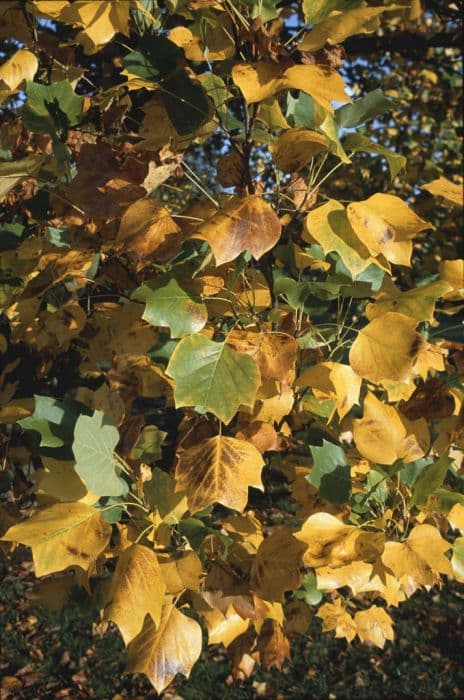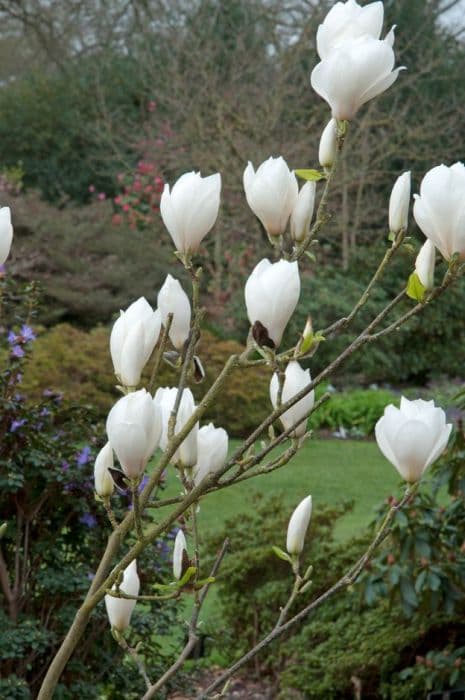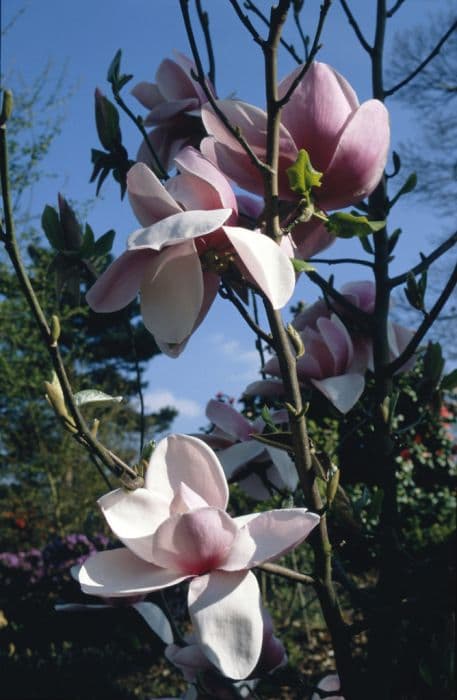Japanese Magnolia Magnolia 'Sayonara'

ABOUT
The Magnolia 'Sayonara' is adorned with elegant, cup-shaped flowers whose beauty is admired by many. These blooms possess an exquisite creamy white complexion, tinged with a delicate pink at the base, providing a subtle hint of color that is visually striking. As the flowers mature, they open wider and can display a more pronounced pink blush. The petals are thick and waxy, adding to the overall luxurious feel of the blossom. Magnolia 'Sayonara' also boasts large, glossy green leaves that create a rich backdrop for the stunning blooms. The leaves are broad and oval-shaped, finishing to a point, providing an aesthetically pleasing contrast to the softness of the flowers. This plant often presents a pyramidal or spreading appearance, complete with multiple branches that create a sanctuary for its flowers. The branches are sturdy and can be covered with fuzzy buds during the dormant season. These buds add another layer of interest to the plant as they hint at the forthcoming floral display that comes with warmer temperatures. The overall aesthetic of the Magnolia 'Sayonara' is one of serene beauty and classic elegance.
About this plant
 Names
NamesFamily
Magnoliaceae
Synonyms
Sayonara Magnolia
Common names
Magnolia 'Sayonara'
 Toxicity
ToxicityTo humans
The Magnolia 'Sayonara', commonly known as Magnolia, does not have a significant level of toxicity to humans. It is generally considered safe, and there are no widely recognized toxic effects from ingesting parts of this plant. However, it is always recommended to exercise caution and avoid eating plant parts that are not known to be edible.
To pets
Magnolia 'Sayonara', commonly known as Magnolia, is generally not toxic to pets. There is little to no risk of poisoning if pets, such as dogs and cats, ingest parts of this plant. However, it is always best to prevent pets from consuming plants as a precaution, since individual animals might have unique sensitivities or allergies.
 Characteristics
CharacteristicsLife cycle
Perennials
Foliage type
Deciduous
Color of leaves
Green
Flower color
Pink
Height
10-20 feet (3-6 meters)
Spread
6-12 feet (1.8-3.6 meters)
Plant type
Tree
Hardiness zones
5
Native area
Asia
Benefits
 General Benefits
General Benefits- Aesthetic Appeal: The Magnolia 'Sayonara' has large, fragrant flowers that enhance the beauty of gardens and landscapes.
- Seasonal Interest: It blooms in early spring, providing an early burst of color after the winter months.
- Wildlife Attraction: Its flowers attract pollinators such as bees and butterflies, supporting local ecosystems.
- Shade Provision: As a tree, it can offer shade in garden settings, reducing local temperature and providing comfort.
- Property Value: Well-maintained magnolias can increase property value by boosting curb appeal.
- Privacy: When planted in a row or group, Magnolia 'Sayonara' can act as a natural privacy screen.
 Medical Properties
Medical Properties- This plant is not used for medical purposes.
 Air-purifying Qualities
Air-purifying QualitiesThis plant is not specifically known for air purifying qualities.
 Other Uses
Other Uses- As a natural dye: The petals of the Magnolia 'Sayonara' can be used to produce a delicate, pale dye for fabrics or paper, offering a touch of natural color.
- Artistic inspiration: Artists may use the form and color of this magnolia's blooms as inspiration for paintings, sculptures, and other artworks.
- Perfumery: The scent of Magnolia 'Sayonara' flowers may be used in crafting perfumes and scented candles, creating a subtle, floral aroma.
- Culinary garnish: The leaves and petals can serve as a decorative garnish for high-end culinary presentations, adding elegance to the dish.
- Photography subject: Due to its striking appearance, photographers may choose Magnolia 'Sayonara' as a subject for botanical and garden photography.
- Wedding decorations: The flowers and branches of the Magnolia 'Sayonara' can be used to create romantic and fragrant wedding bouquets and centerpieces.
- Feng Shui: In Feng Shui, placing this magnolia in certain areas of a home or garden is believed to bring peace and harmony.
- Education: The plant can be used by educators to teach botany and plant science, showcasing its growth habit and bloom cycle.
- Bonsai cultivation: With careful pruning and shaping, Magnolia 'Sayonara' can be grown as a bonsai tree, bringing its beauty to small spaces.
- Eco-printing: Leaves of the Magnolia 'Sayonara' can be used in eco-printing techniques to transfer their outlines and pigments directly onto fabric or paper.
Interesting Facts
 Feng Shui
Feng ShuiThe Magnolia is considered a symbol of purity and nobility in Feng Shui. To harness its positive energy, plant a Magnolia in the front yard to invite success into your life and place it in the southwest area of the garden to enhance love and romantic relationships.
 Zodiac Sign Compitability
Zodiac Sign CompitabilityThe Magnolia is not used in astrology practice.
 Plant Symbolism
Plant Symbolism- Perseverance and Endurance: Magnolias are ancient plants which have existed for millions of years, and they are known to survive challenging conditions, symbolizing strength and the ability to endure life's hardships.
- Dignity and Nobility: The magnolia's large, impressive blooms and towering presence convey a sense of grandeur and regalness, making them symbolic of dignity and nobility.
- Feminine Beauty and Gentleness: With their delicate, fragrant blossoms, magnolias are often associated with the soft, gentle beauty of women.
- Purity and Innocence: The magnolia's white flowers are commonly linked to purity, innocence, and perfection, reflecting the unspoiled beauty of nature.
- Persistence: Magnolias bloom boldly and are one of the first flowers to herald the arrival of spring, representing determination and the will to carry on.
 Water
WaterThe Magnolia 'Sayonara', commonly known as the Japanese magnolia, prefers to be watered deeply but infrequently to encourage deep root growth. During the growing season, water the plant once a week with about 1.5 gallons of water, making sure to moisten the soil down to 12 inches. During the hot summer months, you may need to water twice a week, especially if the weather is particularly dry. In the winter, reduce watering to every two weeks or less, depending on the soil moisture level. Always check the soil before watering; if the top 2 inches are dry, it's time to water your magnolia.
 Light
LightJapanese magnolia thrives in full sun to partial shade conditions. It is best to place the plant in a location where it can receive at least 4 to 6 hours of direct sunlight daily, with some dappled shade in the afternoon to protect it from the intense heat. Avoid deeply shaded areas as insufficient light may lead to fewer blooms and poor growth.
 Temperature
TemperatureJapanese magnolia prefers a temperate climate with temperatures ranging from 20 to 85 degrees Fahrenheit. It can tolerate brief periods of temperatures as low as 10 degrees Fahrenheit, but extended cold can damage the flower buds. The ideal temperature for this magnolia is between 60 and 75 degrees Fahrenheit, as magnolias are generally not suited for extremely hot or cold climates.
 Pruning
PruningPruning the Japanese magnolia should be done to maintain shape, remove damaged or dead branches, and encourage healthy growth. The best time to prune is soon after the tree has finished blooming in spring to minimize the risk of cutting off next year's buds. Pruning should be carried out every year or every other year, depending on the plant's needs and growth pattern.
 Cleaning
CleaningAs needed
 Soil
SoilThe best soil mix for the Magnolia 'Sayonara', commonly known as the Sayonara Magnolia, is one that is rich, porous, and well-draining, with a slightly acidic to neutral pH of 5.5 to 7.0. An ideal soil mix can be created using equal parts loamy soil, peat moss, and perlite or sand to ensure proper drainage and aeration.
 Repotting
RepottingSayonara Magnolia trees do not require frequent repotting; generally, they should be repotted every 2 to 3 years or when they become root-bound. Younger trees may need repotting more regularly, whereas mature magnolias are better off disturbed as little as possible.
 Humidity & Misting
Humidity & MistingSayonara Magnolia prefers average humidity conditions; it can tolerate a range from 40% to 60%. While this plant can adapt to the humidity levels typical in most homes, it thrives when the air isn't too dry.
 Suitable locations
Suitable locationsIndoor
Ensure ample light, well-drained soil, and room to grow.
Outdoor
Plant in sun to partial shade, sheltered from strong winds.
Hardiness zone
5-9 USDA
 Life cycle
Life cycleThe life of the Sayonara Magnolia begins with the germination of seeds, which ideally occurs in moist, well-drained soil and under conditions that include warm temperatures and partial to full sunlight exposure. After germination, the seedling emerges, developing into a juvenile plant with a growth pattern that can be relatively slow as it establishes a strong root system and begins to form its initial leaves and branches. With enough care, including adequate water, nutrients, and protection from pests, the juvenile Magnolia 'Sayonara' transitions into a mature plant, marked by woody growth, a sturdy structure, and the beginning of its flowering phase. Flowering typically occurs in early spring, where the plant produces large, fragrant, tulip-shaped flowers, which are followed by the development of seed cones containing the seeds to propagate the next generation. Following pollination, the seeds mature, the cones release them, and the life cycle has the potential to be continued if the seeds find suitable conditions for germination. The Magnolia 'Sayonara' is perennial and can live for many years, going through repeated cycles of growth, flowering, and seed production.
 Propogation
PropogationPropogation time
Spring-Early Summer
Magnolia 'Sayonara', commonly known as magnolia, is often propagated by semi-hardwood cuttings. This process is usually done in late summer or early autumn. A healthy, disease-free branch is selected, typically 4 to 6 inches (10 to 15 centimeters) long with several leaves. The lower leaves are removed, and the cut end may be treated with a rooting hormone to encourage root development. The cutting is then planted in a well-draining growing medium and is kept under high humidity and indirect sunlight until roots have established, which usually takes a few weeks to a few months.









